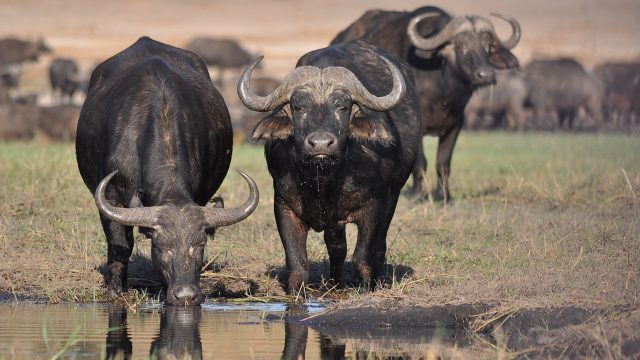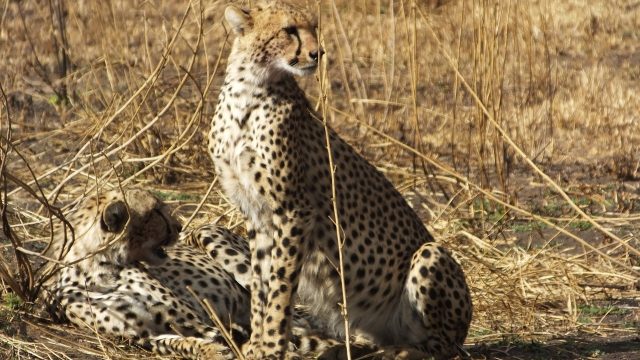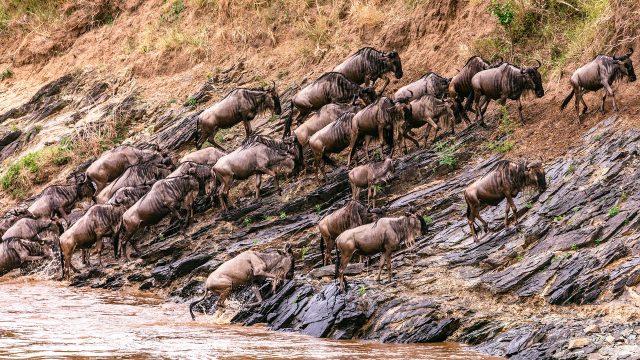Serengeti Wildebeest Migration
- Serengeti
Serengeti Annual Migration ‘the Supreme Experience on Earth’
The Serengeti is a vast ecosystem in east-central Africa. It spans 12,000 square miles (30,000 square kilometers) giving rise to its name, which is derived from the Maasai language and means “endless plains.”
This region of Africa is located in north Tanzania and extends to southwestern Kenya. The Serengeti encompasses Serengeti National Park and a number of protected game reserves and conservation areas maintained by the governments of Tanzania and Kenya. The region hosts the largest mammal migration in the world and is a popular destination for African safaris.
This Great Wildebeest Migration is a movement of about 1.5 million wildebeest all over the Serengeti and Masai Mara bionetworks. 400,000 zebra and 200,000 gazelles escort them along the way, making a total of over 2 million migrating animals. The coolest way to try and understand this Great Migration is as unique mega herds, with a number of smaller fragment herds. It is the mega herd which all maps and illustrations display. If you were to include the splinter herds then it soon becomes evident that the entire Migration can often cover half the entire Serengeti!
So if you are interested on expedition at the heart of the Great Wildebeest Migration, then there is a lot to be said for travelling with the Serengeti’s famous mobile tented camps.
On migration season in Serengeti you will have the opportunity to be in the middle of thousands of Zebras and Wildebeests that gather between the Southern Serengeti plains and Ndutu area (Ngorongoro conservation area) calving . All the new life in the area attracts predator animals like lions, cheetahs, leopards and hyenas to prey on the new born. With luck and excellent guiding, you will have a chance to see exciting things happening in the world of wildlife.
As December approaches the Migration starts to move into the Ndutu region of the Ngorongoro Conservation Area. The short grass plains here are rich in nutritious grasses, providing the herds with the best conditions to raise their newborn. Mid February is calving season when approximately 8,000 wildebeest fawns are born every day for a period of approximately 3 to 4 weeks. The area around Lake Ndutu itself is the place to be at this time of year. The best accommodations are Ndutu Lodge or the mobile camps run by Nomad Tanzania (the Serengeti Safari Camp), & Beyond’s Serengeti Under Canvas, Asilia’s Olakira Camp, Sanctuary Lodges' (Abercrombie’s) and Kusini Camp.
The central Serengeti is known as Seronera, this is the network of different river valleys that ensure year-round water supplies and keep the region amazingly rich in wildlife throughout the year. The area has incredible concentrations of game and sees the migration herd’s move to western Serengeti from mid-April to late June and towards Northern there after back South again in November to December. There is also number of hotels and lodges, for more budget ones they also a chance to stay in public or special campsite.
The Western Corridor follows the path of the Grumeti River up towards Lake Victoria. This region provides superb wildlife viewing action At the end of May there are wildebeest herds spread from the Western corridor through the heart of the park. One group tends to head west into the Western Corridor and crosses the Grumeti River before leaving the park and entering the exclusive Singita Grumeti Reserves. This herd will then head up through the Ikorongo game reserve on the Serengeti's Western corridor before the front runners arrive into the Kogatende area in July. The other herds head directly to the north of the Serengeti, passing straight up the middle through Seronera, Lobo and up to the Bologonja river area near the Eastern border with the Loliondo reserve at Klein’s. It is true to say that at this time herds can be anywhere from the Western corridor through to the Eastern side of the park. Splinter herds will break from the main herds, covering huge areas in their search for fresh grasses
The Northern reaches of the Serengeti remain fantastically quiet and unvisited, due to its relative inaccessibility (a good 6 hour drive from Seronera) and lack of large hotels. The Kogatende area used to be cut off from the rest of the Serengeti, but recent years have seen some of the best camps in the country spring up. This area is mainly use either by extended driving safaris or with flying safari's to two superb permanent tented camps - Sayari Camp and Olakira Camp. From July through to the end of October the Migration is resident in the area and is the finest place to see the Migration's river crossings; as the herds often cross the Mara River daily. This region has been described as 'ultimate paradise' for keen safari buffs and is the best place for walking safari inside the park. All mobile camps move up for here for the whole period, Nomad Serengeti Safari Camp, Mara Under Canvas
7 Days
Big Five Tanzania Safari
- Kilimanjaro / Arusha
- Tarangire, Lake Manyara, Ngorongoro and Serengeti
You will be going on the search for the illusive ‘Big Five’ game: the African lion, leopard, rhino, elephant and buffalo
Tour price from $ 2,920 / person
6 Days
Tanzania Wildlife Safari
- Kilimanjaro / Arusha
- Lake Manyara, Ngorongoro and Serengeti
Discover Africa’s astounding diversity, including the iconic Big Five, in custom-made vehicles with an unobstructed view.
Tour price from $ 2,498 / person
10 Days
Great Migration Safari
- Kilimanjaro / Arusha
- Tarangire, Lake Manyara, Ngorongoro, Serengeti
Track in the footsteps of the Great Migration at the world-famous Serengeti National Park.
Tour price from $ 4,990 / person







